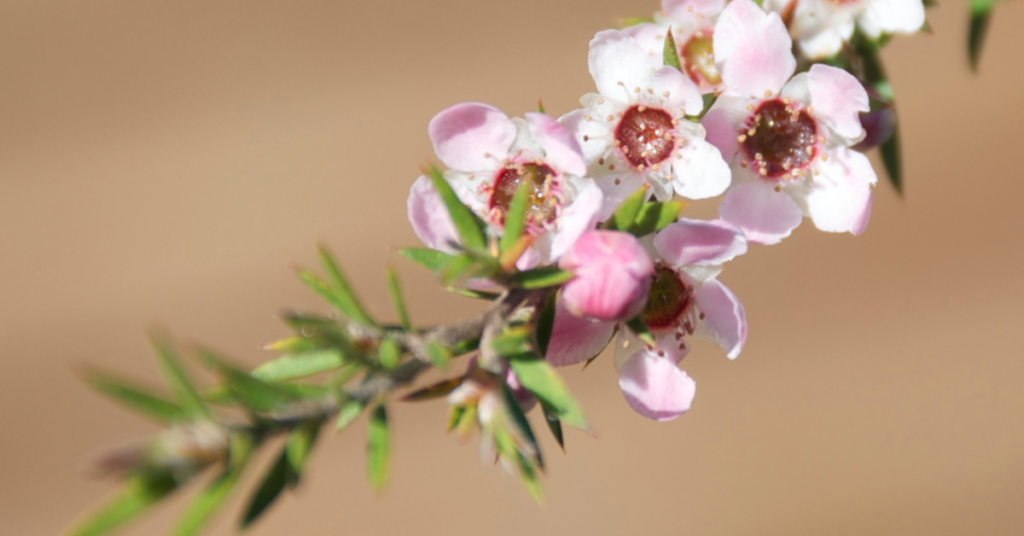Tea tree – Essential Oil
Tea tree (Melaleuca alternifolia)
Tea tree oil has many qualities and can be used to treat a plethora of conditions. Unless you have really sensitive skin, in can be applied undiluted. As our disillusionment with antibiotics has increased, the popularity of this oil has increased too.
Due to its antiseptic qualities, during World War II, Australian soldiers were issued with tea tree oil to treat their wounds. It can also be used to degrease computer keyboards; just put a couple of drops onto a tissue and rub over the keys.
Uses include:
Acne
Mouth ulcers
Cellulite
Hair care
Athlete’s foot
Thrush
Travel sickness
Colds and influenza (flu)
Caution
Do not use on children or babies under the age of 5 years old.
Do not ingest orally.
Acne
Its antibacterial and antiseptic qualities really help with this condition.
Directions for use
Compress: Add 1-2 drops of pure essential oil to 1 litre of warm water. Lay sterile material on the surface of the water thus attracting a film of oil onto the cloth. Apply the material onto the affected area and leave for 10 minutes. Repeat daily.
Facial Massage: Mix 1 drop of pure essential oil to 2 teaspoons of almond or grape seed oil, or any other carrier oil, and rub into face.
Inhalation: Boil 1 litre of water and pour into a bowl, add up to 10 drops of pure essential oil, place a towel over your head and allow steam to rise onto face. Do not do if the skin is very sore as the steam may ‘burn’ already painful skin.
Mouth ulcers
Anti-bacterial. Gargling with tea tree oil will also help in the prevention of plaque build-up.
Directions for use
Mouthwash: Add 1 drop of pure essential oil to a glass of water and swill round the mouth. Always spit solution out, never swallow.
Cellulite
Do not treat this condition with tea tree oil if you have varicose veins or thrombosis
Directions for use
Massage: Mix 20 ml of carrier oil (sweet almond, grape seed) to 10 drops of pure essential oil.
Bath: Add up to 5 drops of pure essential oil to a bath of water and lie back and relax.
Hair care
Helps keep hair looking shiny and healthy.
Final rinse: Add 1-2 drops of pure essential oil to 1 litre of warm water and use as final rinse on hair.
Athlete’s foot
Tea tree oil is an anti-fungal and is therefore highly effective in the treatment of this condition.
Directions for use
Footbath: Put 3 drops of oil in bowl of warm or hot water and soak feet for up to 15 minutes.
Massage: Mix 1 drop of pure essential oil to 2 teaspoons of almond or grape seed oil, or any other carrier oil, and rub into face. Use daily.
Thrush
Tea tree oil is an anti-fungal and is therefore effective in the treatment of this condition.
Directions for use
Bath: Add up to 5 drops of pure essential oil to a bath of water and lie back and relax.
Douche: Add a drop of oil to the water.
Tampon: Soak a tampon in 2 tablespoons of almond oil to which has been added 1 drop of tea tree oil (you can add a drop lavender oil too if you wish). Leave in place for no longer than 4 hours, and then replace with a freshly soaked tampon until the condition eases off.
Travel sickness
Eases symptoms.
Directions for use
Handkerchief: Put a couple of drops of pure essential oil onto a tissue or handkerchief and inhale as and when required.
Colds and influenza (flu)
Clears sinuses; antibacterial and anti-viral qualities aid recovery.
Directions for use
Bath: Add up to 5 drops of pure essential oil to a bath of water and lie back and relax.
Inhalation: Boil 1 litre of water and pour into a bowl, add up to 10 drops of pure essential oil, place a towel over your head and allow steam to rise and inhale. Use once a week.
Handkerchief: Put a couple of drops of pure essential oil onto a tissue or handkerchief and inhale as and when required.
Massage: Mix 20 ml of carrier oil (sweet almond, grape seed) to 10 drops of pure essential oil.
Oil burners: Sprinkle up to 5 drops of pure essential oil onto water and light burner.
Footbath: Put 3 drops of oil in bowl of warm or hot water and soak feet for up to 15 minutes.
Further Information
Where grown: Tree or big shrub native to Australia and a member of the Myrtle family. The leaves are needle-like and are yellow or purple in colour.
Parts used and method of extraction: Leaves of the tree by steam distillation.
Colour and smell: It is pale yellow-green in colour and smells very strong and spicy. You may detect the odour of camphor in it too.
Active ingredients: Pinene, terpineol with cineol, terpinenes, and various alcohols.
Properties: It is active against bacteria, fungi, and viruses.
Mixes well with: Citrus oils, lavender, peppermint.

